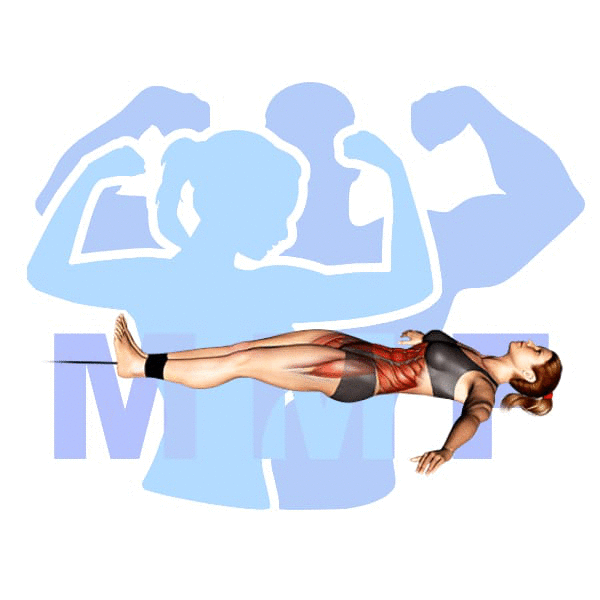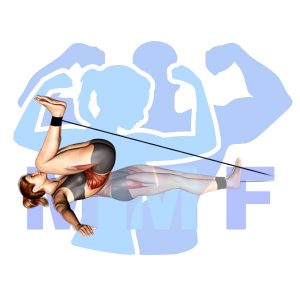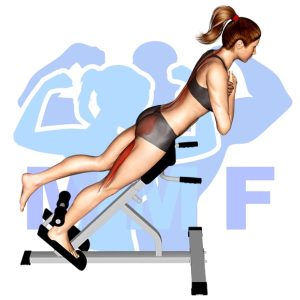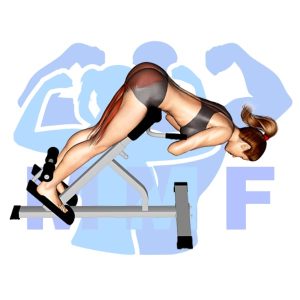Are you tired of performing traditional sit-ups and crunches without seeing any results? Maybe it’s time to switch up your core workout routine with the resistance band reverse sit-up. Many people struggle to target their lower ab muscles despite their best efforts. This is a common problem, as it can be challenging to engage the lower abs without the proper exercise technique. Luckily, the resistance band reverse sit-up is a great solution that isolates the lower abs, creating a more effective and challenging workout. In this blog post, we’ll walk you through the correct form and technique for performing this exercise, so you can start to see the results you’ve been striving for.
Resistance Band Reverse Sit Up Summary
- Primary Muscles: Rectus Abdominis
- Secondary Muscles: Obliques
- Equipment: Resistance Band and Door Anchor
- Mechanics Type: Isolation
- Force: Pull
- Utility: Auxiliary

Resistance Band Reverse Sit Up Instructions
- Attach each end of the resistance bands to each one of your ankles and secure the center of the band to a door anchor close to the base of the door.
- Facing toward the door, step back until the resistance bands are tight.
- Sit then lay down on you back feet towards the anchor.
- Next pull your knees to your chest with your abs lifting your butt off the ground.
- Squeeze your abs at the top and hold. Then slowly extend your legs, but don’t let your feet touch the ground.
- Repeat your sit-ups for your desired number of reps.
Video Tutorial
Resistance Band Reverse Sit Up Muscles
Target (Agonist)
Synergists
Dynamic Stabilizers
- None
Stabilizers
- Deltoid – Posterior
- Latissimus Dorsi
- Pectineus
- Pectoralis Major – Sternal
- Rectus Femoris
- Sartorius
- Tensor Fasciae Latae
- Teres Major
- Triceps – Long Head
Antagonist Stabilizers
- None

Benefits of Resistance Band Reverse Sit Up
The Resistance Band Reverse Sit Up is an excellent exercise for strengthening the Rectus Abdominis muscle, commonly referred to as the “six-pack” muscle. This exercise engages the muscle to a greater degree than a traditional sit up, as the band provides additional resistance throughout the entire range of motion. The exercise also works other muscles in the core and upper body, such as the obliques, lower back, and shoulders. Additionally, because the band provides resistance rather than weight, it can be a great alternative for those looking for a low-impact exercise. Overall, performing Resistance Band Reverse Sit Ups can be a great way to strengthen and tone the core muscles and improve overall fitness.
Tips for Performing Resistance Band Reverse Sit Up
When you wish to attain the fastest results, adhere to these basic tips. Similarly, if you desire to reduce the likelihood of injuries, abide by these tips.
- Add More Bands To Help to Increase The Challenge. When you start to easily do 12 or more reps every set, then you should add to the resistance. You can either do this by elongating the band further at the outset of the action or by adding more bands. The popular technique is to add more bands due to the fact it is readily repeatable to have the same resistance on every workout.
- Focus On How You Breath. For this and most exercises breathing is essential. You should be exhaling out during your primary muscle constriction and breathing in when your primary muscles are expanding.
- Slow Every Rep Down For Better Gains. By increasing the time under tension you are exercising your muscles longer and they will respond by gaining stronger muscles. You can do this without raising the weight by slowing down you reps approximately 4 – 6 seconds flexing and pause then 4 – 6 seconds expanding.
Benefits and Tips Video
Frequent Mistakes To Avoid
You should stop these typical mistakes to support ideal form and improved fitness. Also
- Avoid Cheating. Most of the time, cheating is using momentum rather than the strain of your agonist (target) muscle. Once in a while, a little bit cheating on your final rep can be beneficial to overload your muscle, however not for more than a handful of reps.
- Avoid Using Too Little or Too Much Tension. Not enough, and you will not be sufficiently employing your agonist (target) muscle, a large amount, and you’ll probably cheat. Ensure you can accomplish between 8-12 reps with good form.
Find More Resistance Band Exercises Here
Variations and Complementary Exercises
When performing the Resistance Band Reverse Sit Up, it is important to make sure that you are using the proper form and maintaining good posture. You can also vary the exercise to target different muscles and challenge your body in different ways. Below are some variations, complementary, or alternative exercises for the Resistance Band Reverse Sit Up that work similar muscles.
Resistance Band Straight Leg Raises

Resistance Band Straight Leg Raises is a great complementary exercise for Resistance Band Reverse Sit Ups. This exercise works the lower abdominal muscles and also helps to build core strength. It is done by lying flat on your back with a resistance band looped around your feet. You then lift your legs up to a 90 degree angle, hold for a few seconds, and then slowly lower them back down. This exercise is a great alternative to traditional sit ups as it helps to target the deeper abdominal muscles and can be done anywhere with minimal equipment.
Resistance Band Reverse Sit Up

Resistance Band Reverse Sit Up is a great complementary or alternative exercise to regular sit ups. This exercise works the abdominal muscles as well as the lower back and glutes. The resistance band provides extra tension and resistance on the muscles, forcing them to work harder and more effectively. This exercise is a great way to increase core strength and stability, as well as burning calories and fat. Additionally, it is a great way to increase flexibility and range of motion. Resistance Band Reverse Sit Up is an effective, low-impact exercise that can be done anywhere, making it an excellent choice for those looking for an effective alternative or complementary exercise to regular sit ups.
Lever Lying Crunch (Machine)

The Lever Lying Crunch is an ideal machine for those looking to add additional core strengthening exercises to their routine. It can be used as a complementary or alternative exercise to the Resistance Band Reverse Sit Up, as it works the lower abdominal muscles in a similar way. This machine allows you to control the range of motion and intensity of the exercise, making it a great way to target specific muscle groups. Additionally, the Lever Lying Crunch is a low-impact exercise that can help protect your back from strain during other core exercises.
Check Out These Top Resistance Band Exercises
Legs Up Crunch

Legs Up Crunch is a great complementary or alternative exercise to Resistance Band Reverse Sit Up. This exercise requires you to lie flat on your back with your legs in the air and your knees bent. You then crunch your upper body up while keeping your legs in the air and your feet off the ground. This exercise targets the same core muscles as Resistance Band Reverse Sit Up, but it also challenges your balance and stability. It’s a great way to mix up your routine and add an extra challenge to your core workout.
Leg Raise Hip Lift

The Leg Raise Hip Lift is a great complementary or alternative exercise to the Resistance Band Reverse Sit Up. This exercise focuses on strengthening and stabilizing the core muscles of the lower back and hip region. It requires you to lie flat on your back, with your legs lifted straight out in front of you, and then raise your hips and upper torso up towards the ceiling. You should keep your core tight and your glutes contracted as you lift up, and then slowly lower yourself back down. This exercise helps to strengthen the deep core muscles of the lower back, hips, and abdomen, which are essential for a strong, healthy core.
Knees Up Crunch

Knees Up Crunch is a great exercise to complement the Resistance Band Reverse Sit Up. It works the same muscle groups but in a different way. Knees Up Crunch is a variation on a classic crunch that adds a knee raise to the movement. This movement targets the abdominal muscles, as well as the hip flexors and lower back. The added knee raise helps engage more muscles and increases the intensity of the exercise, making it more challenging and effective. It’s a great alternative or complementary exercise to Resistance Band Reverse Sit Up and can help improve overall core strength and stability.
Find More Abs Exercises Here
Opposing Complementary Exercises
To complement the Resistance Band Reverse Sit Up, you can use the following exercises to target the opposing muscle groups. These exercises will help you to develop a balanced workout and prevent muscle imbalances that can lead to injury.
45 Degree Twisting Hyperextension

The 45 Degree Twisting Hyperextension is a great complement to the Resistance Band Reverse Sit Up exercise, as it focuses on the opposing muscle groups. This exercise targets the lower back and glutes, while the Resistance Band Reverse Sit Up works on the abdominal muscles. The twisting motion involved in the 45 Degree Twisting Hyperextension helps to increase core stability and strength, making it an excellent addition to any workout routine. By working both the abdominal and lower back muscles, this exercise can help to strengthen and tone the entire core, which can lead to improved overall health and fitness.
45 Degree One Leg Hyperextension

The 45 Degree One Leg Hyperextension is a great exercise to complement the Resistance Band Reverse Sit Up as it works the opposing muscle group. This exercise strengthens the hamstrings, glutes and lower back while also helping to improve balance and stability. It can be done with a hyperextension bench or with a dumbbell in each hand. By focusing on the eccentric movement, the athlete can really engage their hamstrings, glutes and lower back while also challenging their balance and stability. This exercise helps to create a balanced strength development of the core muscles, which is essential for athletic performance.
45 Degree Hyperextension

The 45 Degree Hyperextension is a great exercise to complement the Resistance Band Reverse Sit Up. This exercise targets the lower back muscles, which are the opposing muscle group to the abdominal muscles used in the Reverse Sit Up. The 45 Degree Hyperextension helps to build strength and stability in the lower back, improving posture and helping to prevent injuries. By strengthening both the core and the lower back, you will be able to perform your Reverse Sit Ups with better form, improving your overall results.
Get Strong Abs with Resistance Band Reverse Sit Ups
If you are looking to strengthen your core and get those abs to pop, then resistance band reverse sit ups are an excellent exercise to add to your routine. By adding resistance to the movement, you increase the intensity and challenge your muscles even further. This exercise targets the lower abs, which are often the most difficult to engage. Make sure you have proper form and control throughout the movement to ensure maximum effectiveness and avoid any injuries. Incorporate resistance band reverse sit ups into your next workout for a killer core workout.
References: Wikipedia | ExRx.net | PubMed.gov | Comprehensive List of Abs Resistance Band Exercises

